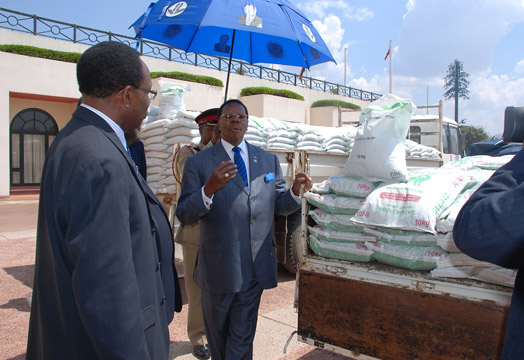CIMMYT’s commitment to Malawi’s agricultural development recognized
On 02 August 2010, Malawi’s Ministry of Agriculture and Food Security held a meeting in Lilongwe, Malawi, for all donor-funded agriculture projects coordinated by international centers operating in the country. This meeting was organized by the Agriculture Sector Wide Approach Program (ASWAP) in order to review how contributions from these projects complement national agricultural initiatives, and to inform the donor community of how their support is making an impact.
CIMMYT, one of eight CGIAR centers working in Malawi, received special recognition from Dr. Andrew Daudi, Malawi’s Principal Secretary for Agriculture, and from Dr. Jeff Luhanga, Controller of Technical and Extension Services. Both acknowledged CIMMYT as a key collaborative partner for maize production technologies, which have helped improve Malawi’s maize-based food security. Specific CIMMYT achievements in Malawi include the development, release, and dissemination of improved maize varieties; the promotion of metal silo technology; training of national scientists; and the adoption of conservation agriculture practices for smallholder farmers.
At the meeting, Mulugetta Mekuria, CIMMYT regional liaison officer and SIMLESA project leader, presented on CIMMYT’s works, focusing on the center’s strong science, partnerships, and capacity building. He also distributed related project briefs from the center. These documents impressed Daudi, who requested that all centers develop similar informational and communicative materials. Meeting attendees all agreed to follow one shared format for these materials to be used in future publications.
Specific CIMMYT initiatives operating in Malawi include: the New Seed Initiative for Maize in Southern Africa (NSIMA); Drought Tolerant Maize for Africa (DTMA); the Effective Grain Storage Project; Sustainable Intensification of Maize Legume Cropping Systems for Food Security in Eastern and Southern Africa (SIMLESA); the Soil Fertility Consortium for Southern Africa (SOFECSA); and work on conservation agriculture in maize-based farming systems.
For more information on CIMMYT’s work in Malawi, see CIMMYT’s June 2010 e-news Maize farmers and seed businesses changing with the times in Malawi.
 Malawi’s President Bingu wa Mutharika hosted CIMMYT’s Wilfred Mwangi, project leader of Drought Tolerant Maize for Africa (DTMA), and Peter Setimela, maize breeder, at the State House in Lilongwe. The two briefed him on CIMMYT’s maize research activities and collaboration in Malawi, which date back to 1974. “The new maize variety, ZM 309, released under the auspices of the DTMA Project, will give Malawi farmers an advantage because it is high yielding and drought tolerant,” said President Bingu wa Mutharika on receiving a 10-ton consignment of ZM 309 seed presented by Mwangi and Setimela on behalf of CIMMYT. “We welcome this research because it will help Malawi cope with climate change and improve food security.”
Malawi’s President Bingu wa Mutharika hosted CIMMYT’s Wilfred Mwangi, project leader of Drought Tolerant Maize for Africa (DTMA), and Peter Setimela, maize breeder, at the State House in Lilongwe. The two briefed him on CIMMYT’s maize research activities and collaboration in Malawi, which date back to 1974. “The new maize variety, ZM 309, released under the auspices of the DTMA Project, will give Malawi farmers an advantage because it is high yielding and drought tolerant,” said President Bingu wa Mutharika on receiving a 10-ton consignment of ZM 309 seed presented by Mwangi and Setimela on behalf of CIMMYT. “We welcome this research because it will help Malawi cope with climate change and improve food security.”